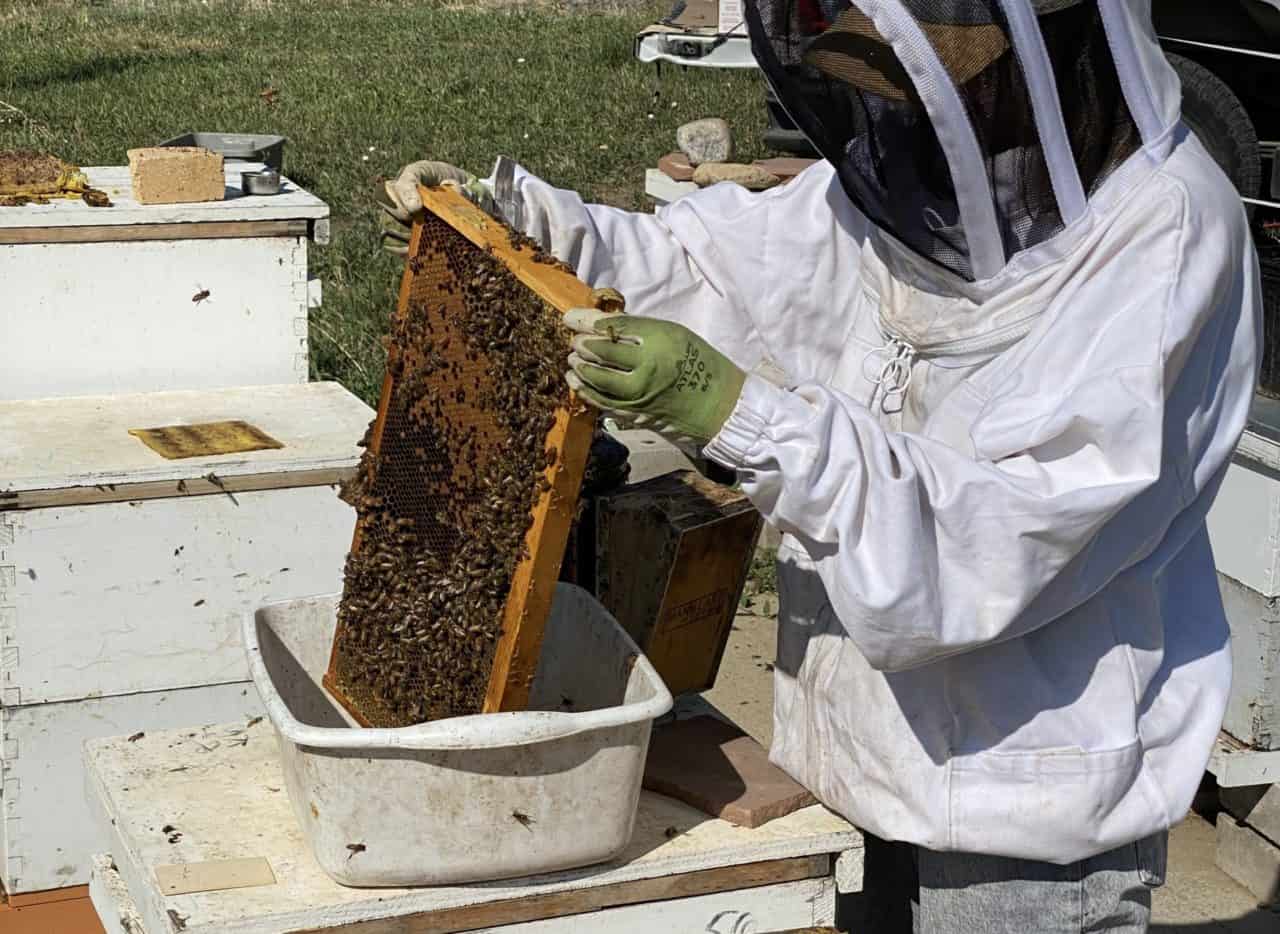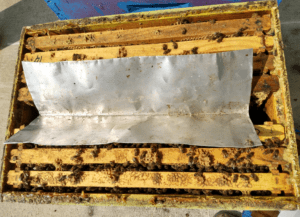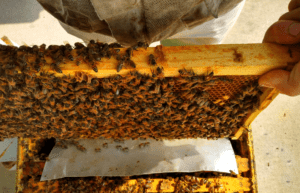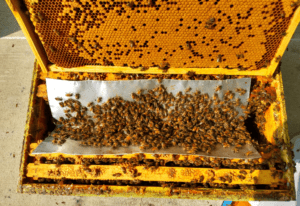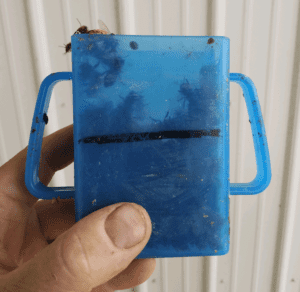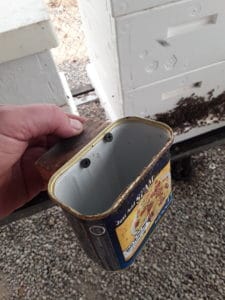To keep healthy bees, beekeepers must monitor their colonies for harmful pests and diseases. This commonly includes testing for the presence and abundance of Varroa, Nosema, and (less frequently) a number viruses and pesticides. To perform these tests beekeepers need to sample their bees. It is not that hard to sample bees, but doing it quickly and accurately is an acquired skill. Of course, there are many good methods for sampling honey bees, but most involve some form of scooping.
Choosing a Frame
Since all of these tests are performed using a small number of bees relative to the total number found in the colony, it is important to consider from what frame to scoop samples. BIP field specialists collect bees for this purpose from a frame that has a combination of open and capped brood. This ensures that nurse bees who tend the developing brood will be collected, and by consistently choosing frames to sample that have the same characteristics, it also allows more accurate comparisons to be made between samples taken from either the same colony at different times, or those collected from different colonies.
Slam Bin Scooping
Slam bin scooping is accomplished by slamming the frame into a bin to dislodge the clinging bees and using a scoop to collect the bee sample from the bin. Of course, the frame is first visually scanned for the queen who, if discovered, is removed prior to slamming. When slamming the frame, hold it vertically and hit the side of the frame facing downwards against a flat spot in the bottom of your slam bin (See Video 1 – “Sampling with a bin”). Set the frame aside, then tilt the bin and bump it so the bees slide to one corner and scoop them out of the bin with your scoop of choice. Round measuring cups work well with smooth-cornered plastic bins. A 1/2 cup measuring cup will hold 300 bees, which is the recommended number for conducting a Varroa alcohol wash. Some BIP field specialists take two 1/4 cup scoops instead of a single 1/2 cup scoop, but either will work, it just depends what works best for you.
During a strong nectar flow, the slam bin method can quickly make a mess of your bin, as any nectar stored in the frame will also come flinging out of any filled, uncapped cells when you slam it. This is fine if you are only collecting a few samples, but it isn’t practical for more than that – the bees will start to stick to the bin’s bottom and will therefore require regular washing.
Question: Slam bin scooping allows older forager bees to fly off before scooping leaving nurse bees behind – could that affect the sample? How?
Death Chute Scooping
If you need to collect a large number of samples, the “Death Chute” scooping method is a better alternative to the slam bin approach. The Death Chute is a piece of metal flashing bent lengthwise into a V profile (8″ wide x 16″ long; Figure 1a). It is used instead of the slam bin to collect the bees and easily fits into the space where you just removed a frame. The chosen frame is then held by the top bar in the same orientation that it was removed from the colony, positioned above the Death Chute and given a firm shake to dislodge the bees (Figures 1b-c). You can then either scoop the bees directly out of the chute, or tip it up at one end, give it a light shake and let the bees slide down into your scoop (hence its ominous name).
Frame Scooping
Frame scooping only requires a scoop. No bin or chute. Most BIP field specialists use frame scooping to sample bees. Of course, not all scoops are created equal, and a diverse array of containers have been adapted for this purpose – some by choice, and others out of necessity (think MacGyver). One of the best scoops for frame scooping is the Juice Box Buddy (Figure 2a). It’s translucent so you can see the bees in the scoop and it’s just the right size and shape. Just draw a line at the ½ cup mark to accurately gauge your 300-bee sample and scoop away. If some kid steals your Juice Box Buddy you may have to resort to other impromptu scoops. A reshaped paper hotel coffee cup can work quite well, or a used aluminum soda can cut in half and bent flat on one side. Of course there is also the classic spam can scoop (Figure 2b). It has a nice flat edge for scooping, and a full spam can holds an even 4 ounces (1/2 cup) of bees.
Some gently press the side of the scoop against the frame of bees down the frame, which rolls the bees off the frame and into the scoop. If the bees are mad, however, I do not recommend this method. I prefer to scoop moving the lip of the scoop upwards on the frame (See Video 2 – “Scooping 200 with Juice Box Holder”). Scooping upward lets you keep a lookout for the queen as you’re scooping away – but, as always, frames should be inspected and the queen removed (if found) before any shaking or scooping takes place.
Bottle Frame Scooping
If samples need to be sent to a lab for analysis, BIP field specialists will usually ship them in plastic screw-top containers. You can use a funnel to transfer bees from the scoop into the sample bottle, or you could collect the bees from the frame using the sample bottle itself as the scoop. No funnel, no bin, just use the lip of the bottle to lift the bees off of the frame and into the bottle (See Video 3 – “Scooping Viral Sample”).
To help U.S. beekeepers monitor the health of their colonies, BIP Field Specialists have performed an untold number of scoops over the years. It’s not surprising that some creative inventions have been devised to make the process more efficient. Such as prototype 1 (P1), a modified a funnel to scoop and stuff at the same time – let’s call it a scoofer (See Video 4 – “Scooping 300 Prototype #1).
Find What Works Best For You
As you can see, there are a number of different scooping strategies that can be used to collect bee samples. Choose the method that is the best fit for you, and continue to regular your colonies for Varroa and other important pests and diseases in order to keep your honey bees healthy!
